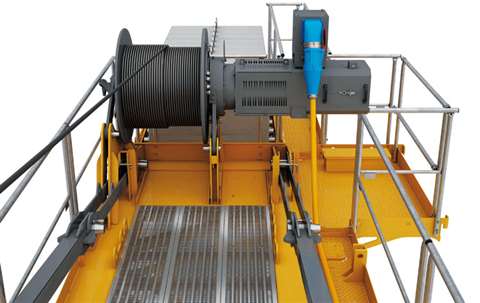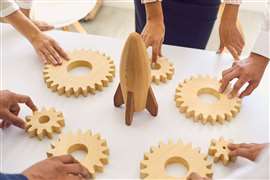Material options for ropes
27 October 2014

New materials and technologies, for example, synthetic fibres and automatic rope adjustment technology, are changing the way that ropes and winches are designed. Laura Hatton reports...
There has been a shift in the industry towards the design of ropes and winches, and many companies are looking towards news technologies and new materials when designing new products.
Crane manufacturer Manitowoc, for example, joined rope manufacturer Samson to design a synthetic rope for the mobile crane market. The KZTM100, a synthetic hoist rope is, according to the manufacturer, 80 % lighter than wire rope and has torque neutral construction that eliminates load spin.
“The new hoist material makes for easy handling, reeving and installation as it reduces kinking, bird caging and damage from other types of cable-spooling issues,” a spokesperson says. “It is also corrosion resistant, requires no lubrication and is easy to work with.”
The latest product from rope specialist Casar, part of the WireCo WorldGroup, in Germany, is the Doublefit. The rope has a round and smooth surface to prevent interlocking and to prevent negative impressions on the rollers and drums. It also has a high filling factor for a high breaking strength.
From rope manufacturer Teufelberger is the 15 mm diameter synthetic Stratos Winch Pro rope (12 mm core plus 3 mm mantle). The rope, marketed under the Stratos Winch Pro brand, is rated for a minimum breaking load of 160 kN and a splice resistance of 150 kN. Dyneema is 15 times stronger by weight than quality steel and up to 40 % stronger than aramid fibres, the manufacturer says.
“Dyneema floats on water, is resistant to moisture, UV irradiation and chemicals, and has been OEKO-TEX certified, which is an independent testing and certification system for textiles,” a spokesperson says.
Advantages such as being lightweight, resistant to moisture and stronger than steel can be beneficial during a lifting application, as a spokesperson from Liebherr-Werk Biberach explains, “On a tower crane with a maximum lifting capacity of 2 tonnes in two-rope mode, the weight of a steel rope with a length of 60 metres is approximately 850 kg, whilst its fibre counterpart would only be around 380 kg. The difference of 470 kg would constitute an increase in lifting capacity at the tip of 18.8 %.”
The safety during the use of any rope, however, depends on the condition of the rope, and this is determined using a discard criteria. For wire ropes, the discard criteria are given in the standard ISO 4309. For wire ropes used in mobile cranes, the two main standards referring to safety are EN 13000:2010 (ISO 4308 in Europe) and B 30.5 (SAE J 959 in the USA).
The time to replace synthetic ropes, however, can be difficult to determine. A spokesperson from manufacturer Casar, explains, “High quality steel wire ropes are designed in a way that the rope clearly shows its criteria for withdrawal from service (for example by a certain number of wire breaks on the surface). Compared to synthetic ropes, this is measured in millions of filaments, which makes the counting of broken fibres impractical.”
Another way to determine when to replace a steel rope is to measure the reduction in diameter. With a synthetic rope, however, filaments of the frayed fibre tends to stay attached to the rope body and can increase the volume between adjacent filaments. “Consequently, a simple diameter measuring will not show the loss of material in the same way as in the case of an abraded steel rope,” a spokesperson from Casar explains. A visual comparator tool which illustrates levels of abrasion (internal and external) can be used to determine this, a spokesperson adds.
New technologies
Just as important for any lifting operation is the winch and hoisting gear. The latest development from Hiab is the crane tip control (CTC) winch system, which allows the vertical movement of the load by using just one lever of the radio controlled crane.
“Creating a vertical lift with a ‘naked’ crane boom requires the crane driver to operate more than one function. This requires some skills and experience,” a spokesperson from Hiab explains. “Our winches are hydraulically driven using steel wire ropes. To increase safety, the electronic torque control is connected to an overload protection system.”
For ensuring rope guidance, Liebherr-Werk Nenzing introduced a horizontal winch shifting system on the RL-K 7500 knuckle boom subsea crane. “It guarantees the ideal fleet angle of the rope under all load conditions in both hoisting and lowering operations,” the manufacturer says. Also from Liebherr is the vertical winch frame lifting system. It has two hydraulic cylinders to allow for the adjustment of the lifting height without moving the drum of the hoisting winch. This design minimises wear of the main wire rope.
New from Liebherr is the SD.shift generation of hoist gear, the prototype of which was first shown in 2013. The new generation of hoist gear has electrically reversible frequency converter hoist gears with SD.shift. The new generation of SD.shift is available in ratings of 65 kW and 110 kW and is used in the 12 to 25 tonne tower crane classes.
“The SD.shift includes a Liebherr asynchronous motor and a wide power and speed range,” a spokesperson from Liebherr explains. “All loads are hoisted in 2-rope mode and always at maximum speed due to the automatic load adjustment system. It has high hoist speeds, low noise level, smooth operation and a compact design. These hoist gears require very little maintenance since the speed of the high performance hoist gear is not adjusted using a gearbox but by an electric switch.”
From Manitowoc are two new variable frequency hoists for Potain tower cranes. The 40 LVF 15 and the 40 LVF 13 hoists are designed for Potain’s MC 125 and MCi 85 A tower cranes, respectively. Each has a 30 kW (40 hp) power rating, with the 40 LVF 15 offering lift speeds of up to 85 m per minute and the 40 LVF 13 reaching lift speeds of up to 81.5 m per minute.
“The new models automatically optimise their speed to the weight of the load on the hook and the winch can be adjusted to power sources using either 50 Hz or 60 Hz” the manufacturer adds. The models are manufactured at the Manitowoc factory in Zhangjiagang, China.
From Palfinger is the synchronised rope control (SRC) system, which automatically adjusts the rope length during crane movement. The system works through the use of sensors in the pully head, which measures movements during crane operation and sends signals directly to the Paltronic 150, a control system which includes an automatic system for increasing the lifting power. The length of rope needed is then calculated and automatically re-adjusted. Also from Palfinger is the rope tension control (RTC) system, which is an automatic rope tensioning device that makes it easier to fold and unfold the crane with the rope reeved in and the fly-jib (additional knuckle boom section) mounted.




